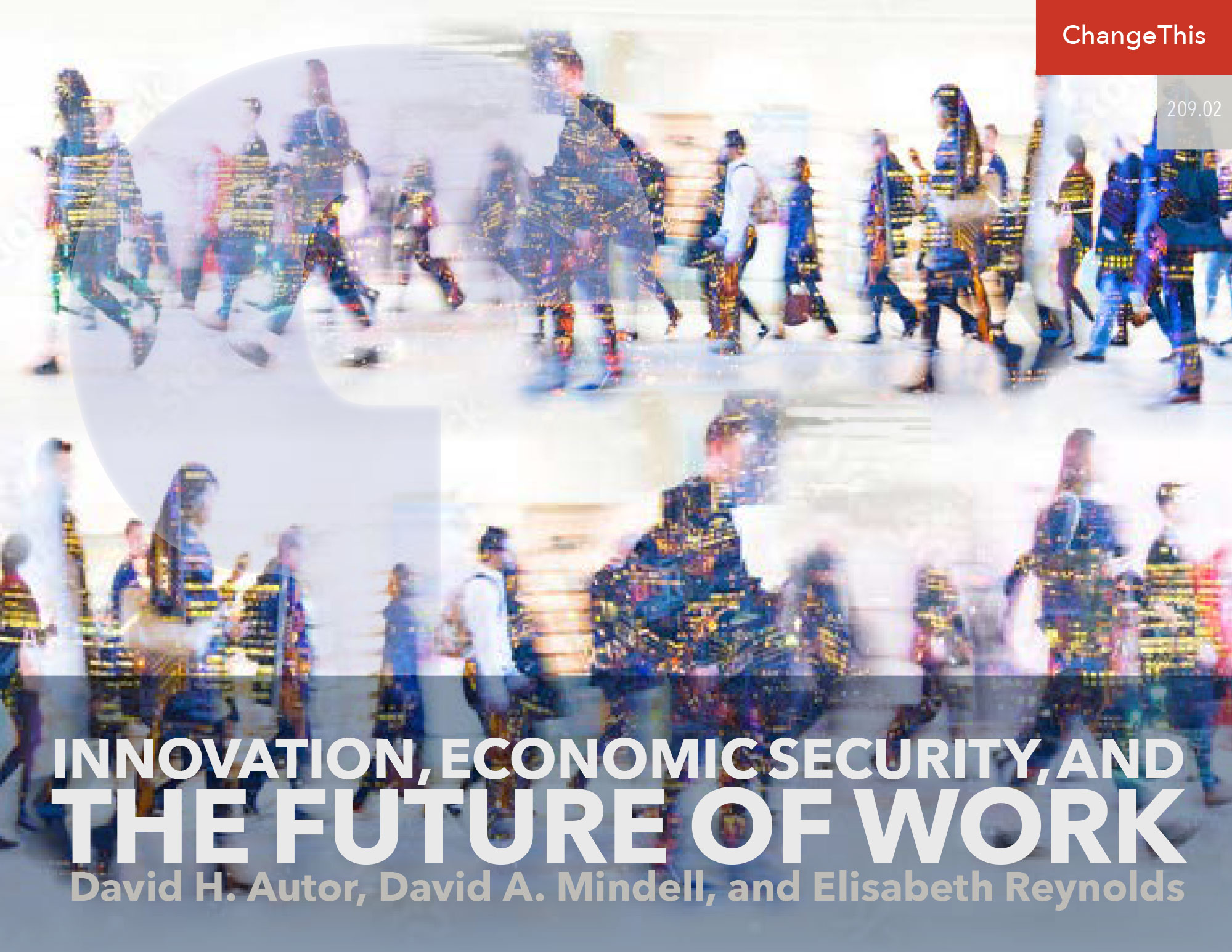Innovation, Economic Security, and The Future of Work
Technological advances are not driving us toward a jobless future.
Over the next two decades, industrialized countries will have more job openings than workers to fill them, and robotics and automation will play an increasingly crucial role in closing these gaps. We will ultimately require more technological advances to address humanity’s most pressing problems, including climate change, disease, poverty, and inadequate education.
Yet advancing robotics, automation, and as yet unforeseen technologies will not necessarily benefit all workers. These technologies, in concert with economic incentives, policy choices, and institutional forces, will alter the set of jobs available, the quality of the jobs, and the skills they demand. Continuous change challenges us to continually balance innovation, growth and equity.
Most of today’s jobs hadn’t even been invented in 1940. Inventing new ways of accomplishing existing work, new business models, and entirely new industries drives rising productivity and new jobs. Innovation brings new occupations to life, generates demands for new forms of expertise, and creates opportunities for rewarding work. What human work will look like a century from now is unknown, but most jobs of tomorrow will be distinct from those today, and will owe their existence to the innovations sprouting from scientific and technological progress.
The economic history of the twentieth century shows that a healthy labor market can serve as the foundation for shared prosperity. Well-designed institutions foster opportunity, buttress economic security, and spur democratic participation. The US must commit to rebuilding this foundation in the twenty-first century. It needs to strengthen and build these institutions, launch new investments, and forge policies that ensure that work remains a central, rewarded, esteemed, and economically viable avenue for most adults to prosper. The three of us co-chaired the MIT Task Force on the Work of the Future over the course of three years, and we found that three essential pillars support building this more equitable and sustainable economy:
INVEST AND INNOVATE IN SKILLS AND TRAINING
Technological innovation will require workers to have both strong foundational skills and specialized training. Yet the Task Force’s research finds that only about half of US workers receive some kind of training from their employers in a given year, and this skews toward higher-educated and nonminority workers. The current US system for training workforce entrants, the currently employed, and displaced workers is fragmented and uneven in quality. It does, however, provide flexibility, which allows workers to move in and out of the system at different points in their careers. Numerous exemplary public, private, and not-for-profit training initiatives exist throughout the country, though some are less successful and most have not been evaluated. Those training models that have been proven successful based on rigorous evaluation should be scaled up to serve many more workers. New technologies, including online instruction, AI-based guided learning systems, and virtual reality tools, offer innovative ways to make training more accessible, affordable, and engaging for students, workers, and job seekers at all stages of the life cycle.
To expand and improve pathways to better jobs:
Foster private sector investment in training, particularly to accelerate upward mobility among lower-wage and less-educated workers, a category in which minority workers are overrepresented. Enact carefully tailored tax code provisions (see above) or matching fund programs to encourage employer-provided training that leads to recognized, verifiable credentials.
- Significantly increase federal funding for training programs that can lead to middle-class jobs for workers without four-year degrees. Support should be offered on a competitive basis to community colleges and labor market intermediaries that can demonstrate they are working closely with employers, providing support services to participants (i.e., coaching, advising, child care, and transportation), and investing in innovative training programs that include work-based learning—elements shown to be keys to success. Encourage the formation of regional compacts formed by employers, governments, community colleges, and community groups that come together with shared commitments to build skill development systems that meet employer needs.
- Support policies that raise degree completion rates at community colleges. Policies should include funding and incentives to redesign the curriculum to integrate (rather than sequence) remedial education and vocational training, create shorter courses that provide usable credentials on the path to a degree, and provide more financial support over shorter intervals to allow adults to focus on studies rather than work while enrolled.
- Require, and fully fund, rigorous evaluations of training programs to gauge efficacy in achieving employment and earnings outcomes.
- Invest in demonstration programs that test innovative ideas for retraining and reemploying dislocated adult workers, a challenge where policy and programs have thus far had limited success.
- Improve labor market information to support workers seeking jobs and jobs seeking workers. Invest in the modernization of traditional “one-stop” centers for unemployed workers while also creating online databases that provide real-time information about job opportunities. Continue to develop ways for workers to easily access to their own data on skills, competencies, and credentials, bearing in mind that job search assistance is a complement to, rather than a substitute for, effective education and training programs.
- Invest in developing and field testing innovative methods and tools for delivering training. Evidence also suggests that online training works best when paired with in-person offerings. Support instructional models that include hands-on learning, potentially using augmented and virtual reality.
IMPROVE JOB QUALITY
As in other countries, a growing share of US employment for workers without four-year college degrees is found in traditionally low-paid service jobs: food service, cleaning and groundskeeping, security, entertainment and recreation, and home health assistance. US workers in these occupations fare worse than in other high-income countries, receiving extremely low pay, irregular schedules, and little or no employment security. They rarely have access to employer-provided health insurance, paid family or medical leave, or vacation time. Adjusting for purchasing power, low-paid Americans are paid 26 percent less than low-paid Canadians.
This needn’t be the case.
The following steps will help to ensure that low-paid jobs provide a modicum of economic security and access to social benefits:
- Restore the real value of the federal minimum wage to at least 40 percent of the national median wage, and index this value to inflation. Localities should be able to set higher levels, as they do currently. Minimum wages are particularly effective at bolstering the earnings of minority workers who are overrepresented at the lower tail of the US wage distribution. The best available economic evidence indicates that well-calibrated minimum wages exert only modest to undetectable adverse effects on employment, but they do reduce household poverty.
- Modernize unemployment insurance (UI) benefits and extend them to workers who have not been traditionally covered:
- Allow workers to count their most recent earnings toward determining eligibility: At the start of 2019, thirty-seven states allowed workers who did not qualify for benefits using the standard approach to use earnings during a more recent period to establish benefit eligibility. This policy should be adopted nationally.
- Determine UI eligibility based on hours rather than earnings: At present, low-wage workers must work more hours than high-wage workers to qualify for UI. Already in place in the state of Washington, all states should be required to enable workers to qualify for unemployment benefits by having worked a minimum number of hours rather than having made a minimum level of earnings.
- Drop the requirement that the unemployed seek full-time work: Whether because of family responsibilities or the nature of their jobs, many workers hold part-time positions. Any unemployed worker who searches for part-time work of twenty hours or more per week and who otherwise qualifies for unemployment insurance benefits should be allowed to collect benefits.
- Reform partial UI benefits: States should be required to reevaluate their partial unemployment benefit formulas to better protect workers who lose a substantial fraction of their work hours, including when hours are lost because the worker has lost a second job. In most states, a low-wage worker whose earnings are cut in half would currently receive no benefits.
- Strengthen and adapt labor laws and better enforce them. As private sector labor unions have dwindled, rank-and-file workers have lost the capacity to bargain for wage growth to match productivity growth. Innovation is badly needed in worker representation, but the provisions of US labor law retard the development of alternative approaches. In contrast to the situation in countries like Germany, for example, it is illegal in the US for workers to create work councils at nonunion businesses, and it is unclear whether workers can legally serve on corporate boards.
Key sectors of the workforce, specifically domestic workers and agricultural workers, are excluded from collective bargaining, a legacy of racial politics during the New Deal. The National Labor Relations Act, which has only been amended once in the eighty-five years since its passage (and in that case, to weaken it), requires modernization. The US needs to enable new institutions for collective bargaining to form without undermining the strength of current unions. Action is needed on three fronts:- Open up labor law to allow innovation in new forms of representation in workplace and corporate decision-making and governance.
- Build legal protections that allow workers to organize without risk of retaliation in nontraditional realms, such as such as domestic and home-care worker, farm work, and independent contracting.
- Strengthen the law and more vigorously enforce protections and processes for workers to gain access to collective bargaining.
EXPAND AND SHAPE INNOVATION
Innovation is key to creating jobs and wealth, and to meeting rising competitive challenges from abroad. The US needs to commit to an innovation agenda that is targeted toward creating social benefits and augmenting rather than replacing workers.
Today, too few of the benefits of innovation-driven growth are flowing to workers. We should steer innovation for the benefit of all stakeholders. Federal policy has clearly been shown to be valuable in seeding innovation, generating economic growth, building areas of educational and research excellence, and spurring new work creation. But publicly directed US innovative effort is slackening, measured either relative to historical levels of public R&D investment or in comparison to effort in other countries, such as Germany and China.
The tax laws that shape corporate investment in workers and machines also need rebalancing. Tax law changes enacted over the last four decades have increasingly skewed the US tax code toward subsidizing machinery purchases rather than investing in workers.
Tax policy offers firms an incentive to automate tasks that, absent the distortions of the tax code, they would accomplish with workers. The US should bring its tax code back into balance to align incentives for innovation in skills development, capital formation, and R&D investment. Below is a list of our specific recommendations.
- Increase federal R&D spending and direct it toward areas neglected by the private sector. The private sector faces weak incentives to invest in long-term, fundamental research and to pursue innovations that address the social implications of technologies. Public investments should focus on technologies and applications to solve our most pressing national problems, including climate change, human health, and poverty alleviation.
- Set national research goals to enhance human capabilities and support equitable labor markets through such research areas as human-centered AI, collaborative robotics, and the science of learning and education.
- Offer targeted assistance to SMEs to increase productivity through the adoption of new technologies. Explore ways that federal programs or departments (e.g., DOD, NIST) could assist in technology upgrading in particular in manufacturing SMEs, possibly through the Manufacturing Extension Partnership and the Manufacturing USA Network.
- Expand the geography of innovation in the US. Innovation is increasingly concentrated geographically. Yet the country has significant assets in its universities, entrepreneurs, and workers that are dispersed throughout the country. With relatively modest amounts of funds and building on existing assets, the US innovation agenda should look to spread the benefits of innovation to a broader set of workers and regions.
- Rebalance taxes on capital and labor by altering the ways the tax code currently unduly favors investments in capital. Eliminate accelerated depreciation allowances, which exacerbate this imbalance.
- Apply the corporate income tax equally to all corporations, including S-corporations. The differential tax treatment of C and S corporations leads to extensive tax arbitrage that relabels labor income as tax-favored capital income. Expanding the tax base is always the most efficient way of raising tax revenue.
- While maintaining the federal R&D tax credit, enact an employer training tax credit, akin to the R&D tax credit, that applies exclusively to training investments in workers that lead to externally recognized certifications.
Too many Americans fear that technological progress will make the country wealthier while threatening their livelihoods.
The remarkable history of American innovation was powered not by fear or fatalism, but by a profound sense of possibility. Those possibilities remain. We see no tradeoff between improving economic security for workers and embracing ongoing technological change and innovation; arguably, accomplishing the latter requires ensuring the former. Achieving both goals will require both technological and institutional innovation.
Excerpted from The Work of the Future: Building Better Jobs in an Age of Intelligent Machines
by David Autor, David A. Mindell and Elisabeth B. Reynolds. Reprinted with permission from the MIT PRESS.
Copyright © 2022 Massachusetts Institute of Technology.
ABOUT THE AUTHORS
David Autor is Ford Professor in the MIT Department of Economics.
David A. Mindell is Professor of Aeronautics and Astronautics and Dibner Professor of the History of Engineering and Manufacturing at MIT and founder and CEO of Humatics Corporation. Autor and Mindell were Cochairs of the MIT Task Force on the Work of the Future.
Elisabeth Reynolds is Special Assistant to the President for Manufacturing and Economic Development at the National Economic Council and was Executive Director of the MIT Task Force on the Work of the Future.












































